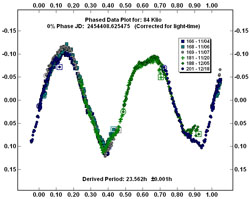Asteroid CCD Photometry and Analysis of Minor Planets
 Most asteroids have orbits between Mars and Jupiter, and are generally believed to be the original planetesimals prevented by nearby Jupiter from ever collecting into a planet. Through the history of the solar system collisions have broken pieces off all of them and shattered some. Most have too small mass for gravity to pull them into near spherical shape. As they rotate wide and narrow area sides are alternately presented toward Sun and Earth, and their brightness typically changes from maximum to minimum twice with each rotational cycle. A graph of magnitude versus time is called the lightcurve. The time between alternate (not consecutive) maxima is the rotation period, the difference in brightness between maximum and minimum represents the elongation, and irregularities in the lightcurve indicate irregularities in the shape. The study of rotational properties of asteroids has yielded much information on the collisional history of the asteroid belt.
Most asteroids have orbits between Mars and Jupiter, and are generally believed to be the original planetesimals prevented by nearby Jupiter from ever collecting into a planet. Through the history of the solar system collisions have broken pieces off all of them and shattered some. Most have too small mass for gravity to pull them into near spherical shape. As they rotate wide and narrow area sides are alternately presented toward Sun and Earth, and their brightness typically changes from maximum to minimum twice with each rotational cycle. A graph of magnitude versus time is called the lightcurve. The time between alternate (not consecutive) maxima is the rotation period, the difference in brightness between maximum and minimum represents the elongation, and irregularities in the lightcurve indicate irregularities in the shape. The study of rotational properties of asteroids has yielded much information on the collisional history of the asteroid belt.
ASLC member, Frederick Pilcher, uses a 14 inch telescope and CCD camera to obtain images from a particular minor planet for several nights. He uses special software to calculate the change in brightness of the minor planet compared with nearby stars, and constructs a lightcurve from the results. The resulting curve helps to define the rotational period of the asteroid and also provides information regarding its shape.
ASLC is proud to host the results of Fred's Minor Planet Studies. Click here or on the light curve thumbnail above to access his Minor Planet Light Curve data.
- contributed by Fred Pilcher
Measuring Asteroid Sizes and Shapes Using Occultations
 Every now and then, an asteroid (minor planet) passes exactly between a star and a small area on Earth. For a brief time, the star's light is completely obscured by the asteroid. How long the star's light is blocked (occulted) by the asteroid, and how large an area that the occultation can be observed can give astronomers an excellent idea as to the size and also the shape of the asteroid. The study is known as occultation timing. In order for the results to be accurate and complete, many astronomers situated along the path of the occultation make very accurate measurements of exactly when the star disappeared and when it reappeared.
Every now and then, an asteroid (minor planet) passes exactly between a star and a small area on Earth. For a brief time, the star's light is completely obscured by the asteroid. How long the star's light is blocked (occulted) by the asteroid, and how large an area that the occultation can be observed can give astronomers an excellent idea as to the size and also the shape of the asteroid. The study is known as occultation timing. In order for the results to be accurate and complete, many astronomers situated along the path of the occultation make very accurate measurements of exactly when the star disappeared and when it reappeared.
Usually, the event is recorded using a video camera. Periodic audible signals from the Atomic clock (obtained via short wave radio) are also recorded on the videotape. Measurements can then be determined with accuracies within a few hundredths of a second. The precise location of the observations are determined using GPS receivers. The results are sent to the International Occultation TIming Association (IOTA) where size and shape calculations are made based on the duration of the occultation and the known speed and distance of the asteroid. Several ASLC members regularly participate in these measurements - both from home observatories and from mobile set-ups.
- contributed by Rich Richins
Click here to read about additional science conducted by ASLC Astronomers

